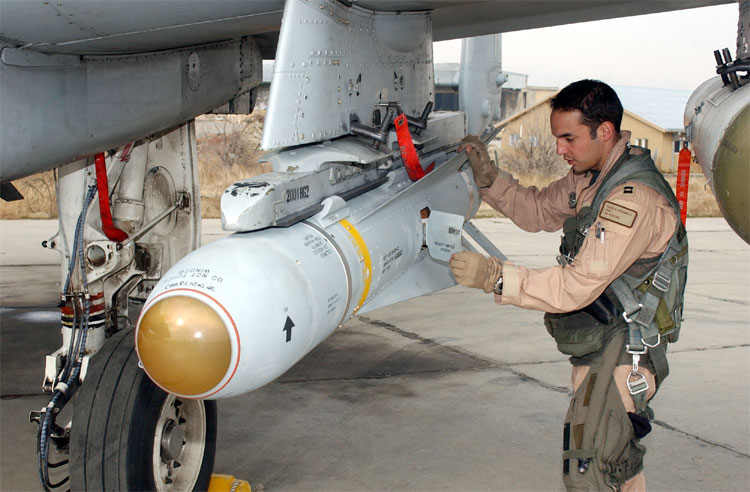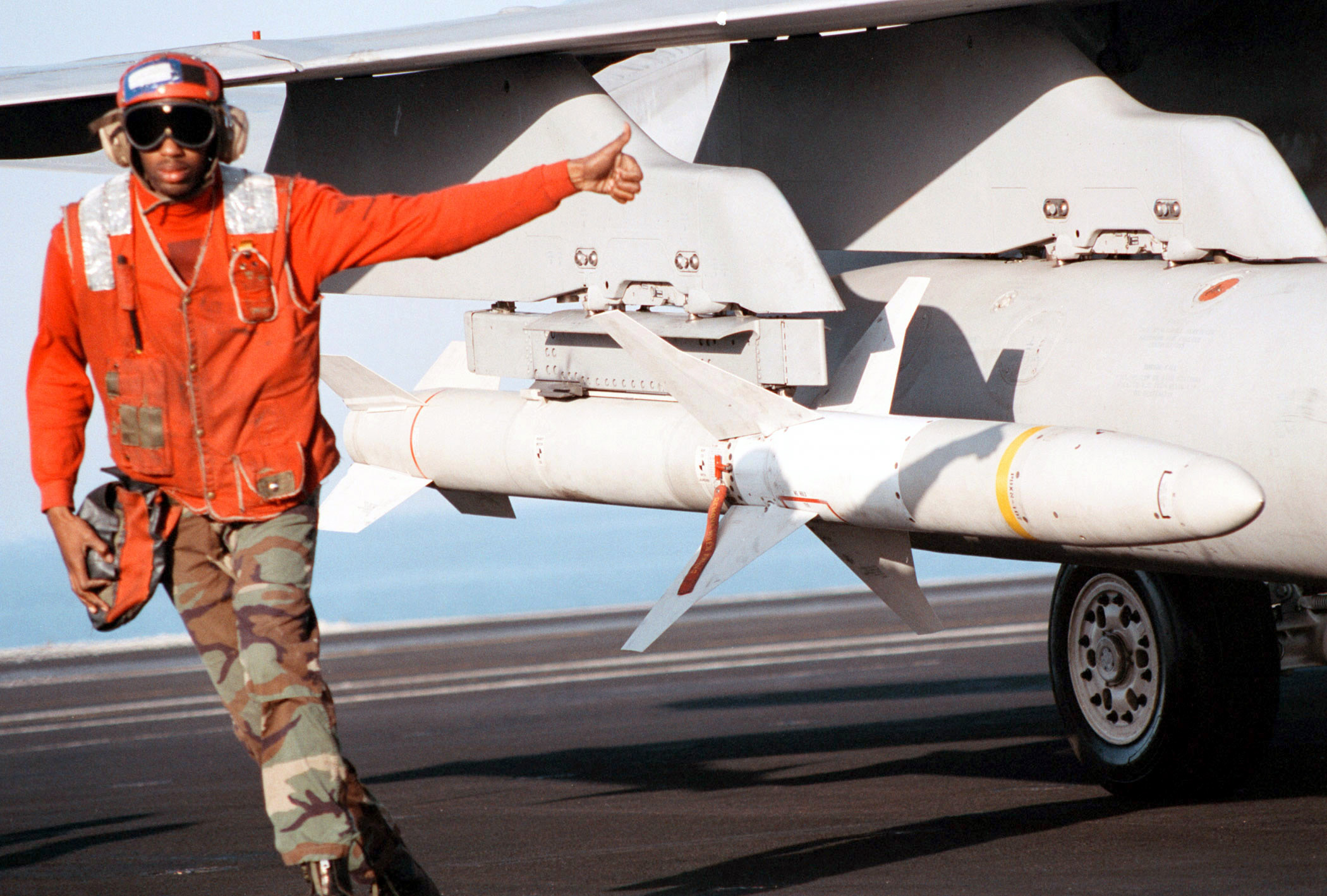|
ARMAT
ARMAT is a French anti-radar missile. It is a development of the Anglo-French Martel. It was adopted by the French Air Force and exported to several other countries, and has been used in combat by Iraq. Development Martel was developed as a joint Anglo-French programme in two versions, a TV-guided version, which was only used by the British, and an anti-radar version, which was used by both countries When it came to replace Martel, Britain and France pursued separate programmes, with British Aerospace developing the Sea Eagle anti-ship missile (which used a similar airframe to Martel but powered by a turbojet and with active radar homing and the smaller ALARM anti-radar missile. To meet France's requirements for an anti-radar missile, French company Matra developed the Martel into the ARMAT (Anti-Radar Matra), with work beginning in 1979. This used the same airframe as the Martel, but with a higher impulse rocket motor, and an improved homing seeker and electronics. ARMAT is repo ... [...More Info...] [...Related Items...] OR: [Wikipedia] [Google] [Baidu] |
Martel Missile
The Martel is an Anglo-French missile. The name Martel is a contraction of ''Missile, Anti-Radiation, Television'', referring to the guidance options. There are two variants, the passive radar anti-radiation missile version, AS.37, and the television guided anti-ship missile, AJ 168. The aircraft that used these missiles were the Blackburn Buccaneer (up to three TV or four ARM variant), the SEPECAT Jaguar (two), the Mirage III/ F1 (one or two), and the Hawker Siddeley Nimrod (at least one). The Martel was suited to anti-ship attack with its long range and heavy warhead. There was not, at the time, a small radar homing missile like the AGM-84 Harpoon with an active radar, so the only viable solution was a video or ARM sensor. With a relatively long range, a heavy payload, and a subsonic speed, this missile compares more to an anti-ship weapon like the Exocet or the AS.34 Kormoran than an anti-radar missile. It weighs three times as much as the AGM-45 Shrike, with half the s ... [...More Info...] [...Related Items...] OR: [Wikipedia] [Google] [Baidu] |
Air-to-surface Missiles Of The Cold War
An air-to-surface missile (ASM) or air-to-ground missile (AGM) is a missile designed to be launched from military aircraft at targets on land or sea. There are also unpowered guided glide bombs not considered missiles. The two most common propulsion systems for air-to-surface missiles are rocket motors, usually with shorter range, and slower, longer-range jet engines. Some Soviet-designed air-to-surface missiles are powered by ramjets, giving them both long range and high speed. Guidance for air-to-surface missiles is typically via laser guidance, infrared guidance, optical guidance or via satellite guidance signals. The type of guidance depends on the type of target. Ships, for example, may be detected via passive radar or active radar homing, which is less effective against multiple, small, fast-moving land targets. There is some cross-over between air-to-surface missiles and surface-to-surface missiles. For example, there was an air-launched version of the Tomahawk missi ... [...More Info...] [...Related Items...] OR: [Wikipedia] [Google] [Baidu] |
ALARM (missile)
ALARM (Air Launched Anti-Radiation Missile) is a British anti-radiation missile designed primarily to destroy enemy radars for the purpose of Suppression of Enemy Air Defenses (SEAD). It was used by the RAF and is still used by the Royal Saudi Air Force. The weapon was retired by the UK at the end of 2013. History The Ministry of Defence received offers for a new anti-radiation missile in late 1982; British Aerospace Dynamics offered ALARM while Texas Instruments teamed with Lucas Aerospace offered its HARM missile. Defence Secretary Michael Heseltine announced the selection of ALARM on 29 July 1983. The initial order was 750 missiles for the RAF. The selection process was controversial; the battle between the contractors was bitter, the Ministry of Defence favoured ALARM to retain UK industrial capabilities while the Treasury favoured the cheaper and proven HARM. In early 1986, BAe recognised that Royal Ordnance was having difficulties delivering the missile's motor ... [...More Info...] [...Related Items...] OR: [Wikipedia] [Google] [Baidu] |
Matra
Matra (an acronym for Mécanique Aviation Traction) was a major French industrial Conglomerate (company), conglomerate. Its business activities covered a wide range of industries, notably aerospace manufacturer, aerospace, defence industry, defence, automotive industry, automotive, motorsports, transport and telecommunications. Following the acquisition of vehicle manufacturer Automobiles René Bonnet, the company founded Matra Automobiles during the 1960s, which produced a limited range of racing and sports cars. Its car division worked closely with other vehicle manufacturers, most significantly Renault, prior to the decline and sale of Matra Automobiles during the early 2000s. In addition to road cars, Matra entered into a wide range of businesses, eventually diversifying into Media (communication), media, weaponry, aeronautics, automobiles, and music distribution. Matra was at one point owned by the Floirat family. Throughout much of the company's existence, French business ... [...More Info...] [...Related Items...] OR: [Wikipedia] [Google] [Baidu] |
Iran–Iraq War
The Iran–Iraq War, also known as the First Gulf War, was an armed conflict between Iran and Iraq that lasted from September 1980 to August 1988. Active hostilities began with the Iraqi invasion of Iran and lasted for nearly eight years, until the acceptance of United Nations Security Council Resolution 598 by both sides. Iraq's primary rationale for the attack against Iran cited the need to prevent Ruhollah Khomeini—who had spearheaded the Iranian revolution in 1979—from exporting the new Iranian ideology to Iraq. There were also fears among the Iraqi leadership of Saddam Hussein that Iran, a theocratic state with a population predominantly composed of Shia Muslims, would exploit sectarian tensions in Iraq by rallying Iraq's Shia majority against the Baʽathist government, which was officially secular but dominated by Sunni Muslims. Iraq also wished to replace Iran as the power player in the Persian Gulf, which was not seen as an achievable objective prior to the Is ... [...More Info...] [...Related Items...] OR: [Wikipedia] [Google] [Baidu] |
Military Equipment Introduced In The 1980s
A military, also known collectively as armed forces, is a heavily armed, highly organized force primarily intended for warfare. Militaries are typically authorized and maintained by a sovereign state, with their members identifiable by a distinct military uniform. They may consist of one or more military branches such as an army, navy, air force, space force, marines, or coast guard. The main task of a military is usually defined as defence of their state and its interests against external armed threats. In broad usage, the terms "armed forces" and "military" are often synonymous, although in technical usage a distinction is sometimes made in which a country's armed forces may include other paramilitary forces such as armed police. Beyond warfare, the military may be employed in additional sanctioned and non-sanctioned functions within the state, including internal security threats, crowd control, promotion of political agendas, emergency services and reconstruction, pro ... [...More Info...] [...Related Items...] OR: [Wikipedia] [Google] [Baidu] |
Bréguet 1150 Atlantic
The Breguet Br.1150 Atlantic is a long-range maritime patrol aircraft designed and manufactured by French aircraft manufacturer Breguet Aviation. Designed in response to a 1958 NATO specification as a replacement for the Lockheed P2V Neptune, Breguet's submission was declared the winner over several competing bids. To produce the Atlantic, a multinational consortium, ''Société d'Étude et de Construction de Breguet Atlantic'' (SECBAT), was established. During 1963, an initial order for 60 Atlantics 40 for France and 20 for Germany was received. Follow-on orders from export customers followed shortly thereafter. It was first introduced to operational service during 1965. The Atlantic has been operated by a total of five countries, commonly performing maritime roles such as reconnaissance and anti-submarine warfare. The Atlantic is also capable of carrying air-to-ground munitions to perform ground-attack missions; a small number of aircraft were also equipped to perform ELINT op ... [...More Info...] [...Related Items...] OR: [Wikipedia] [Google] [Baidu] |
SEPECAT Jaguar
The SEPECAT Jaguar is a British-French supersonic jet attack aircraft originally used by the British Royal Air Force and the French Air Force in the close air support and nuclear strike role. As of 2025, the Jaguar remains in service with the Indian Air Force. Originally conceived in the 1960s as a jet trainer with a light ground attack capability, the requirement for the aircraft soon changed to include supersonic performance, reconnaissance and tactical nuclear weapon, tactical nuclear strike roles. A carrier-based variant was also planned for French Navy service, but this was cancelled in favour of the cheaper, fully French-built Dassault-Breguet Super Étendard. The aircraft were manufactured by SEPECAT (''Société Européenne de Production de l'avion Ecole de Combat et d'Appui Tactique''), a joint venture between Bréguet Aviation, Breguet and the British Aircraft Corporation, one of the first major joint British-French military aircraft programmes. The Jaguar was expor ... [...More Info...] [...Related Items...] OR: [Wikipedia] [Google] [Baidu] |
Mirage 2000
The Dassault Mirage 2000 is a French multirole, single-engine, delta wing, fourth-generation jet fighter manufactured by Dassault Aviation. It was designed in the late 1970s as a lightweight fighter to replace the Mirage III for the French Air Force (''Armée de l'air''). The Mirage 2000 evolved into a multirole aircraft with several variants developed, with sales to a number of nations. It was later developed into the Mirage 2000N and 2000D strike variants, the improved Mirage 2000-5, and several export variants. Over 600 aircraft were built and it has been in service with nine nations. Development Previous projects The origins of the Mirage 2000 could be traced back to 1965, when France and Britain agreed to develop the "Anglo-French Variable Geometry" ( AFVG) swing-wing aircraft. Two years later, France withdrew from the project on grounds of costs, after which Britain would collaborate with West Germany and Italy to ultimately produce the Panavia Tornado. Dassault in ... [...More Info...] [...Related Items...] OR: [Wikipedia] [Google] [Baidu] |
Mirage F
A mirage is a naturally-occurring optical phenomenon in which light rays bend via refraction to produce a displaced image of distant objects or the sky. The word comes to English via the French ''(se) mirer'', from the Latin ''mirari'', meaning "to look at, to wonder at". Mirages can be categorized as "inferior" (meaning lower), "superior" (meaning higher) and " Fata Morgana", one kind of superior mirage consisting of a series of unusually elaborate, vertically stacked images, which form one rapidly-changing mirage. In contrast to a hallucination, a mirage is a real optical phenomenon that can be captured on camera, since light rays are actually refracted to form the false image at the observer's location. What the image appears to represent, however, is determined by the interpretive faculties of the human mind. For example, inferior images on land are very easily mistaken for the reflections from a small body of water. Inferior mirage In an inferior mirage, the mirage imag ... [...More Info...] [...Related Items...] OR: [Wikipedia] [Google] [Baidu] |
Anti-radar Missile
An anti-radiation missile (ARM) is a missile designed to detect and home in on an enemy radio emission source. Typically, these are designed for use against an enemy radar, although jammers and even radios used for communications can also be targeted in this manner. The earliest known anti-radiation weapon is a variant of the Blohm & Voss BV 246 radar guided bomb.Lepage, Jean-Denis G.G. (2009). Aircraft of the Luftwaffe 1935-1945. McFarland. p. 67. . Home-on-jam As jammers proliferated, a number of existing ARMs such as the AGM-88 HARM was modified to also target jammers as the source of radiation. Jammers also led to the addition of a feature to missiles that usually use a different targeting mode (e.g. active radar homing, semi-active radar homing, GPS), allowing them to switch to an anti-radiation targeting mode when radar deteriorates too much. Some examples are: * JDAM and JDAM-ER, air-to-surface GPS bomb * AMRAAM, active radar homing air-to-air missile * R-77, ac ... [...More Info...] [...Related Items...] OR: [Wikipedia] [Google] [Baidu] |









